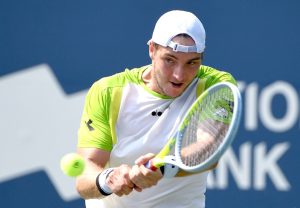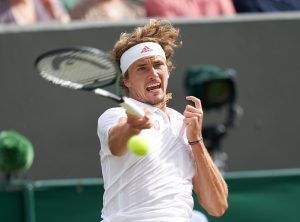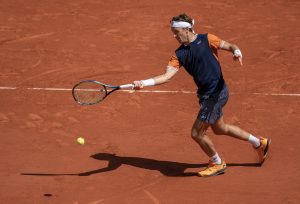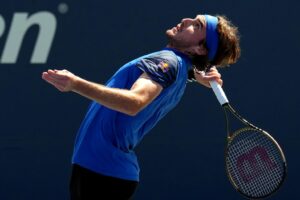In an ideal world, of course, tennis would now be in its off-season, enabling players to rest up and remodel their game where necessary in time for the start of the new season ahead, which will begin in earnest with the Australian Open in January. However, as we are constantly reminded – not least by the ongoing uncertainty over the whereabouts of Peng Shuai – this is far from an ideal world, for tennis or anything else.
Nevertheless, the trilogy of end-of-season finals that formally mark the end of the ATP and WTA Tours – the NextGen Finals, the WTA Finals and the ATP Finals – have provided a spectacular end to 2021 and suggest that 2022 will be a stupendous year for tennis, in both the men’s and women’s game.
The NextGen Finals: No Escape From Alcaraz
The NextGen Finals – or to give the event its full title, the Next Generation ATP Finals – for the best male players under the age of 21 has been one of the finest additions to the ATP Tour in recent years, living up to its title by acting as a springboard for young players to launch themselves into the global tennis consciousness and then progress up the rankings. Since they began in 2017, three of the four winners (there was no event last year, because of the pandemic) have undoubtedly proved themselves to be future stars, with Stefanos Tsitsipas (the 2018 champion) and Jannik Sinner (the 2019 winner) already in the world’s top 10, and this year’s winner, Carlos Alcaraz, likely to join them in the near future.
Indeed, only the very first winner of the event in 2017, South Korea’s Chung Hyeon, has failed to push on significantly since his triumph, and that is down to the succession of injuries that he has suffered and the accompanying loss of form rather than any lack of natural ability. However, for all the giant strides taken by Tsitsipas and Sinner, both of whom qualified for this year’s ATP Finals (albeit that Sinner was there as an alternate after his compatriot Matteo Berrettini was forced out by injury), it is possible that Alcaraz will surpass them both, and soon. The 18-year-old Spaniard has been the quintessential slow burner this year, making considerable progress during the European clay court season and then reaching the quarter-finals of the US Open.
However, it was in Milan at the NextGen Finals that he arguably proved his sheer singularity as a young male player, through the apparent effortlessness with which he dispatched all of his fellow future stars. That was most pronounced in the final against Sebastian Korda, the second-ranked player in the tournament after Alcaraz himself, who is so tall, lean and powerful that he almost looked like an over-age player allowed to compete with a younger age group. However, Alcaraz first showed that he has the big serve and even bigger forehand to match if not outpace Korda, before unleashing the full arsenal of all his skills.
That arsenal is formidable, to say the least. It is obviously extremely early days in Alcaraz’s career, but it is not too early to suggest that he might just emerge to be the ultimate post-Big Three player, precisely because he combines at least a little of the defining qualities of each of those 20-Major-winning champions: Nadal-like intensity; Federer-like flair; and Djokovic-esque resilience. That is not to say that he will match the multiple-Major-winning achievements of those champions (that is surely too much to expect). It is merely to suggest that he looks by far the best of all the young players who will eventually succeed those truly great players.
Alcaraz may have one other unique weapon at his disposal. His coach, Juan Carlos Ferrero, was a Major winner, but only once, triumphing at Roland Garros in 2003 before the emergence of The Big Three soon afterwards put paid to any chance he had of winning another Major, even in Paris. Consequently, having had his hopes of future Major success effectively stolen from him by Nadal, Federer and Djokovic, he may take exquisite revenge by helping to fashion a player who puts together the best attributes of those three geniuses in one package. If he does, he may end up winning the multiple Majors as a coach that he could not win as a player.
The WTA Finals: Proof Of The Ultra-Competitiveness of Women’s Tennis
Such has been the phenomenal success of the NextGen Finals that it is reasonable to ask why there is not a women’s/WTA equivalent. One answer might be that, like women and girls in general, female tennis players develop so much more quickly than their male counterparts that they have no need for a NextGen event, because they are already winning Majors. In recent years, that has been proven by Naomi Osaka, Bianca Andreescu and Iga Swiatek, who all won Majors before they were 21, and it was reinforced emphatically this year by Emma Raducanu, who not only won the US Open as a qualifier but did so aged only 18.
Remarkably, of those “Now Generation” stars, as Martina Navratilova christened them, only Swiatek qualified (or was sufficiently fit, either physically or mentally, to attend) the WTA Finals in Guadalajara, Mexico, and the brilliant young Pole was eliminated at the group stage after losing her first two matches. That showed that for all the precocity of youth, there are still older female players who can compete with and even beat them, as epitomised by the two finalists: eventual winner Garbiñe Muguruza, a two-time former Major winner who finally seems to be rediscovering the form that took her briefly to world #1; and Anett Kontaveit, who for so long had been a relative journeywoman but at the end of this year transformed herself into a winning machine, so much so that she nearly went all the way to the WTA Finals title.
Embed from Getty Images
The emergence of so many young players, coupled with the re-emergence of former champions like Muguruza and the full emergence of an experienced player like Kontaveit, is all further proof, if it were needed, of the competitiveness of women’s tennis right now. Indeed, women’s tennis is not only the most generally and genuinely competitive that it has ever been since the creation of the WTA Tour in 1973. It may just be the most generally and genuinely competitive of all major professional sports at present, including all the male versions of those sports.
Ash Barty has just been confirmed as the year-end world #1 singles player for the third year in a row, a feat previously only achieved by Chris Evert, Martina Navratilova, Steffi Graf and Serena Williams. Nevertheless, no-one could seriously argue that the Australian, superb as she is, has achieved anything like the domination of women’s tennis that those fantastic four players did in their hey-day. Instead, Barty is the best player at a time of relentless, indeed historic, competitiveness in women’s tennis that looks unlikely to diminish at any point in the near future, to the extent that the idea of a dominant women’s world #1, of the kind that Chrissie, Martina, Steffi and Serena all were at one point in their career, may just become a thing of the past.
The ATP Finals: A New Big Two?
Unlike the NextGen Finals and the WTA Finals, the ATP Finals in Turin (its new home after more than a decade in London) has yet to reach its conclusion. However, there is probably a new world and numerical order in men’s tennis. That is because after “The Big Three” we may now have a “New Big Two”: Novak Djokovic and Daniil Medvedev.
Both men have done so much to separate themselves from their supposed peers or contemporaries that they are deserving of this new consideration of their joint talents. Djokovic, of course, won three out of the four Majors this year and finished as a year-ending world #1 for a record seventh time. His defeat at the hands of Alexander Zverev in the semifinals in Turin, though doubtless disappointing, has not taken much of the shine off the Serbian’s remarkable year.
That is because 2021 was the year that Djokovic surely proved, beyond all reasonable doubt, that he is the best player of The Big Three, after beating Nadal in a truly epic French Open semifinal that may just have been the best match ever played on clay, and certainly the best of the Open era. In vanquishing Nadal for a second time at Roland Garros (having previously beaten him in the 2015 quarterfinals), just as he has now beaten Federer in three successive Wimbledon finals (2014, 2015 and 2019), Djokovic can claim to have beaten both his major rivals at least twice on their favourite surface at their favourite Slam, a feat that neither Federer nor Nadal has come close to matching.
Medvedev, of course, was the only man to beat Djokovic at a Major this year, denying him the Calendar Slam at the US Open, in what was his own coming-of-age party at a Major. Dominic Thiem may have won the same event the year before, but the Austrian has been beset by injuries ever since, whereas Medvedev has used his New York triumph as a genuine springboard to attain a remarkable level of consistency ever since. He reached the Paris Masters final, where he lost to Djokovic, and has now booked his place in the final in Turin. Consequently, for the moment at least, he can be considered to have proved himself by far the best player outside The Big Three, eclipsing his contemporaries such as Tsitsipas and perhaps especially Zverev, who he has not lost to for two years.
It is highly unlikely that “The New Big Two” will have anything like the staying power of “The Big Three”, not least because Djokovic is already 34, making him nearly a full decade older than the 25-year-old Medvedev. Nevertheless, for the time being at least, they seem to have raised themselves above the level of all other male players, old and young, and consequently will be the favourites, injuries permitting, to make the Australian Open Final again in January. And if they do, it is likely to be far more competitive than Djokovic’s utter destruction of Medvedev in the Australian Final this year.
All Of Which Should Make For A Great 2022
Tennis, like almost everything else over the last 18 months or so, has endured two seasons that have been terribly affected by Covid. Of course, the biggest impact on the sport has been the absence of fans, either partially or totally, and even the three End Of Season Finals events were not yet at full crowd capacity.
However, with the announcement this week that the Australian Open will welcome full crowds in January after Covid restrictions were eased in the state of Victoria, there is at last hope for a season full of fans in 2022. And that, even more than the emergence of great players like Alcaraz, the re-emergence of great players like Muguruza and the possible development of a new world order in men’s tennis with a “New Big Two”, is the real cause for optimism about the year ahead in tennis.
Main photo:
Embed from Getty Images






